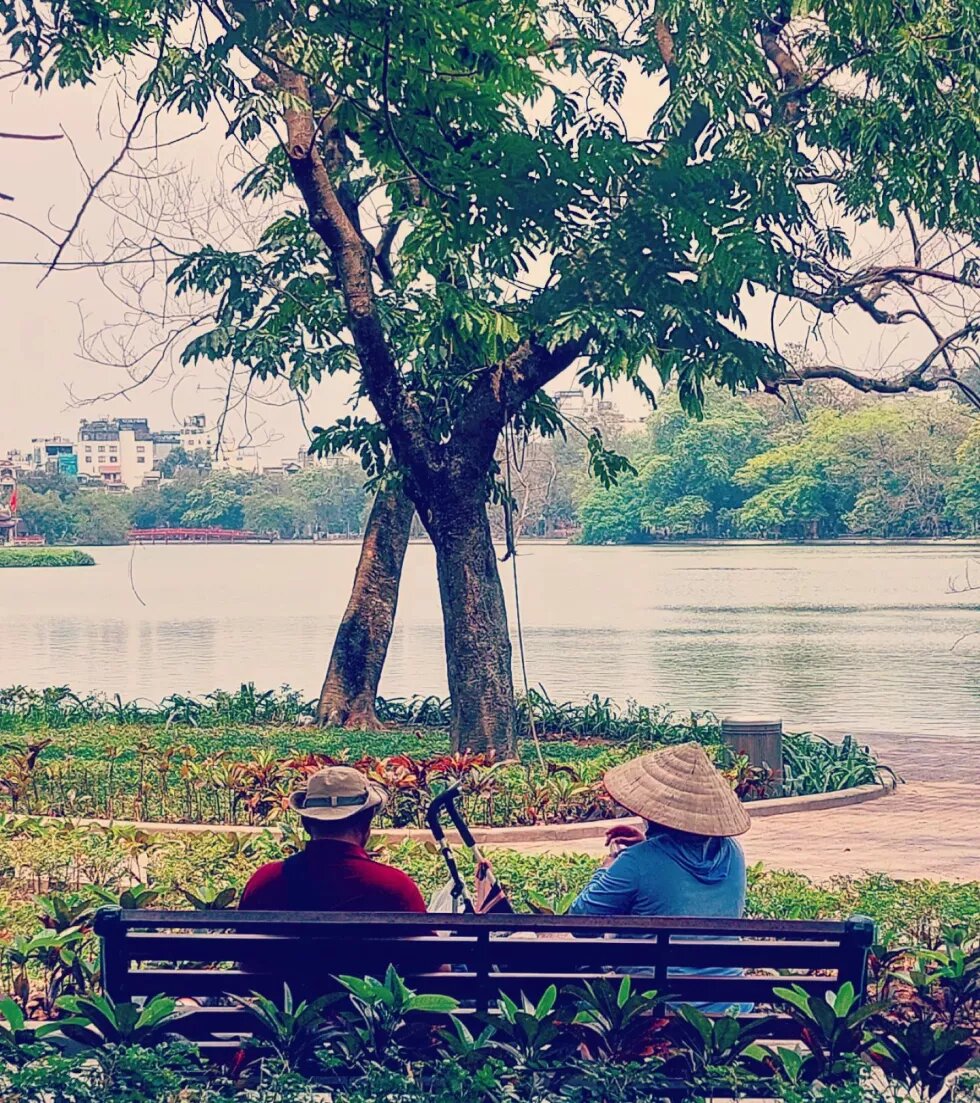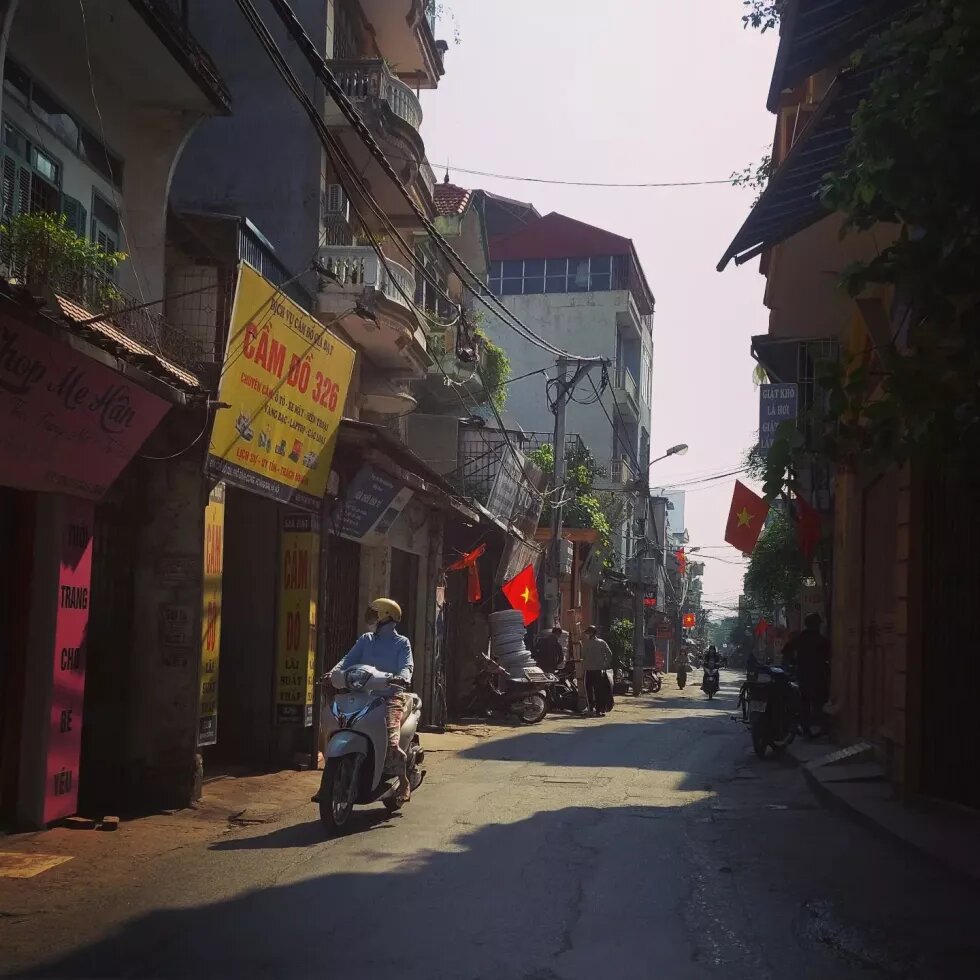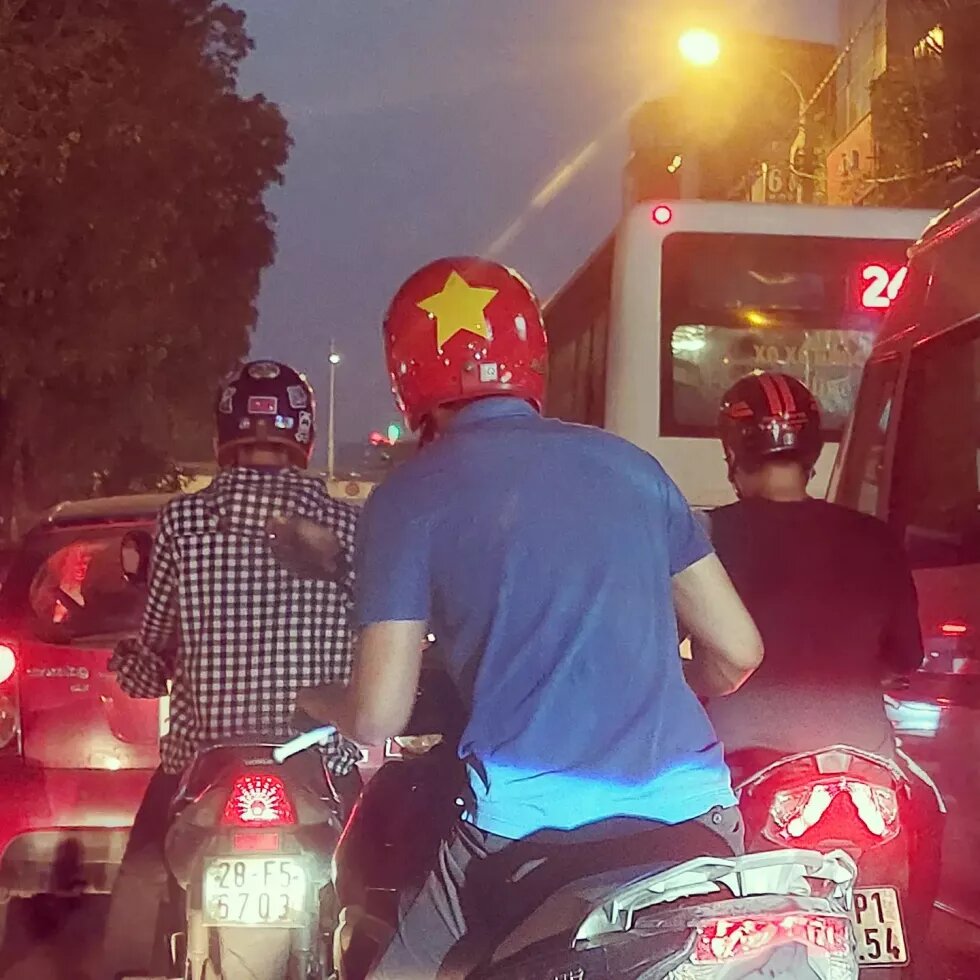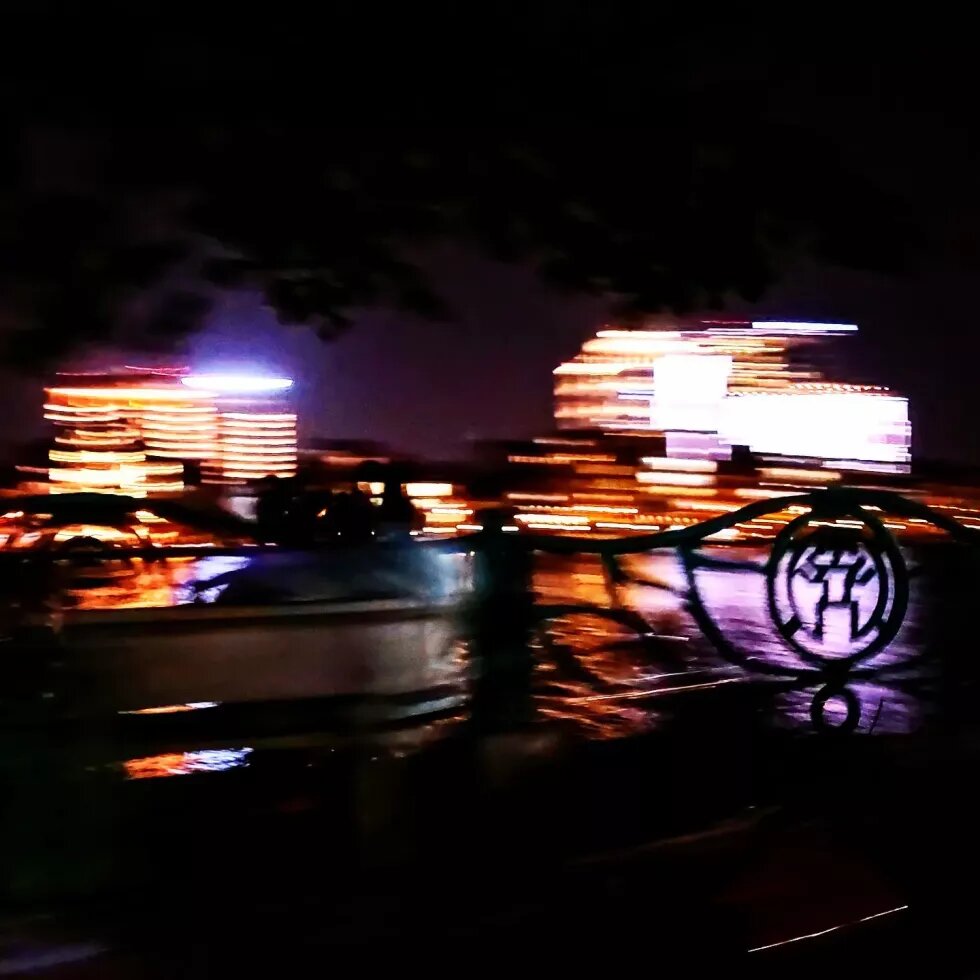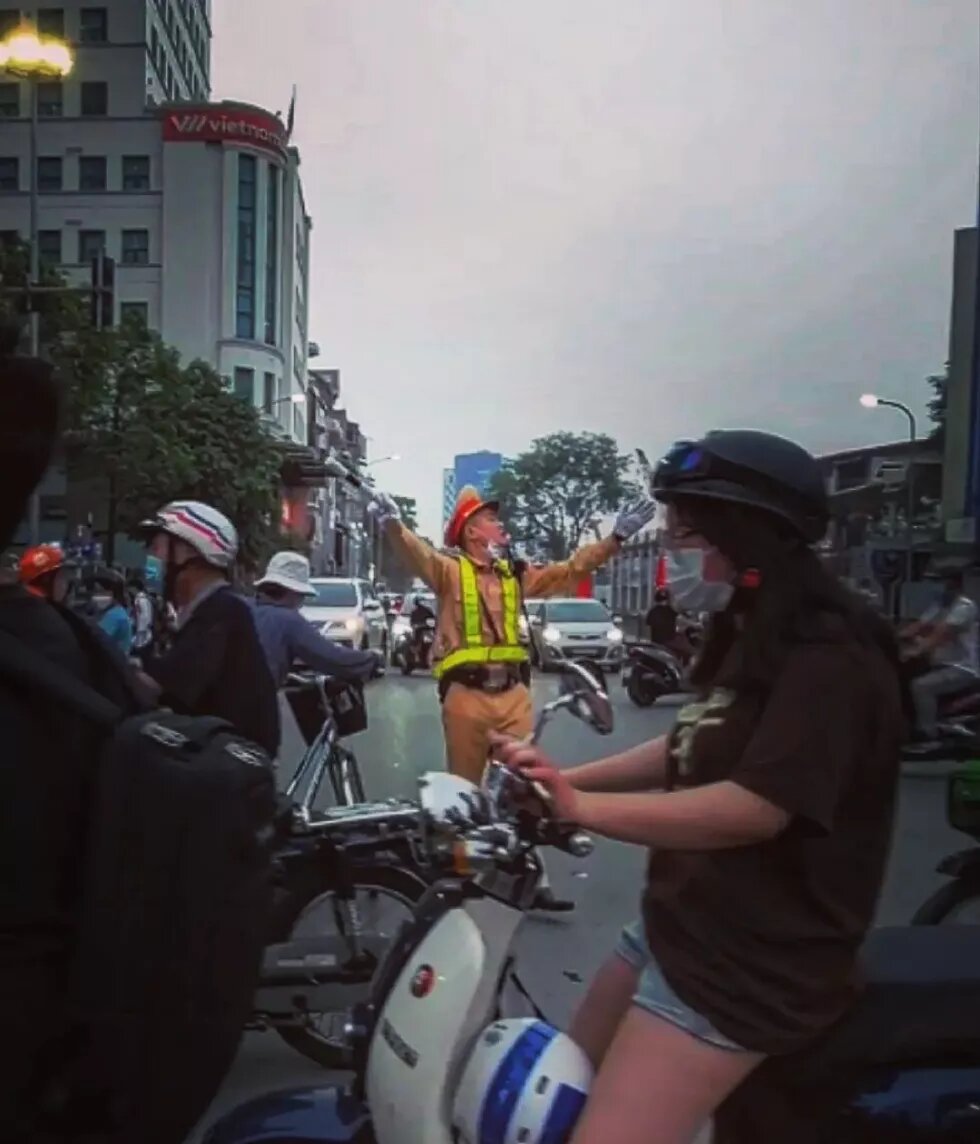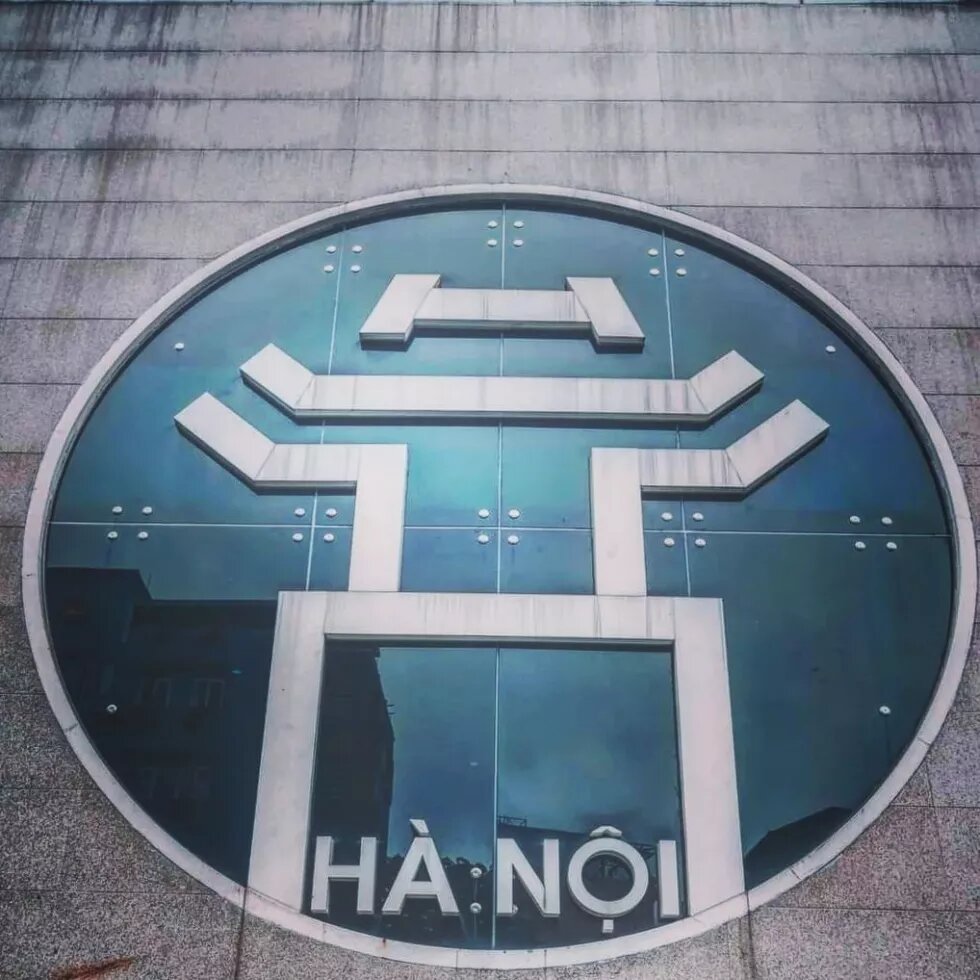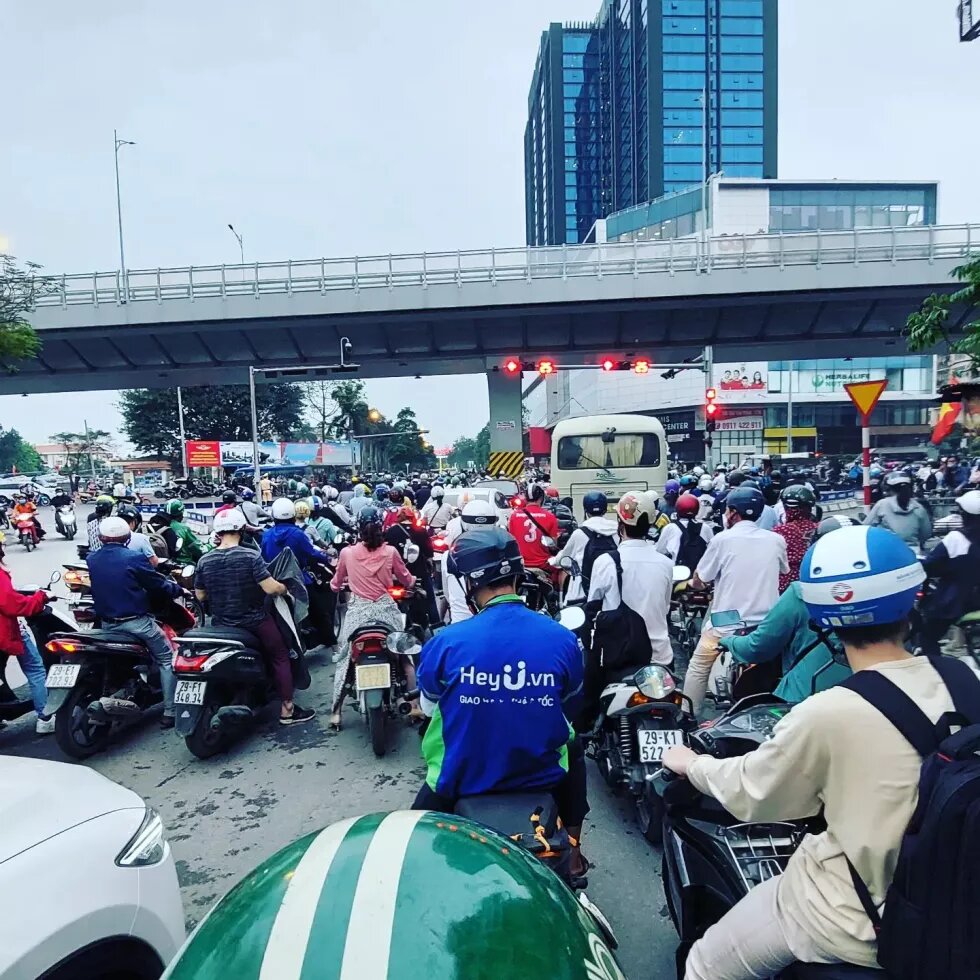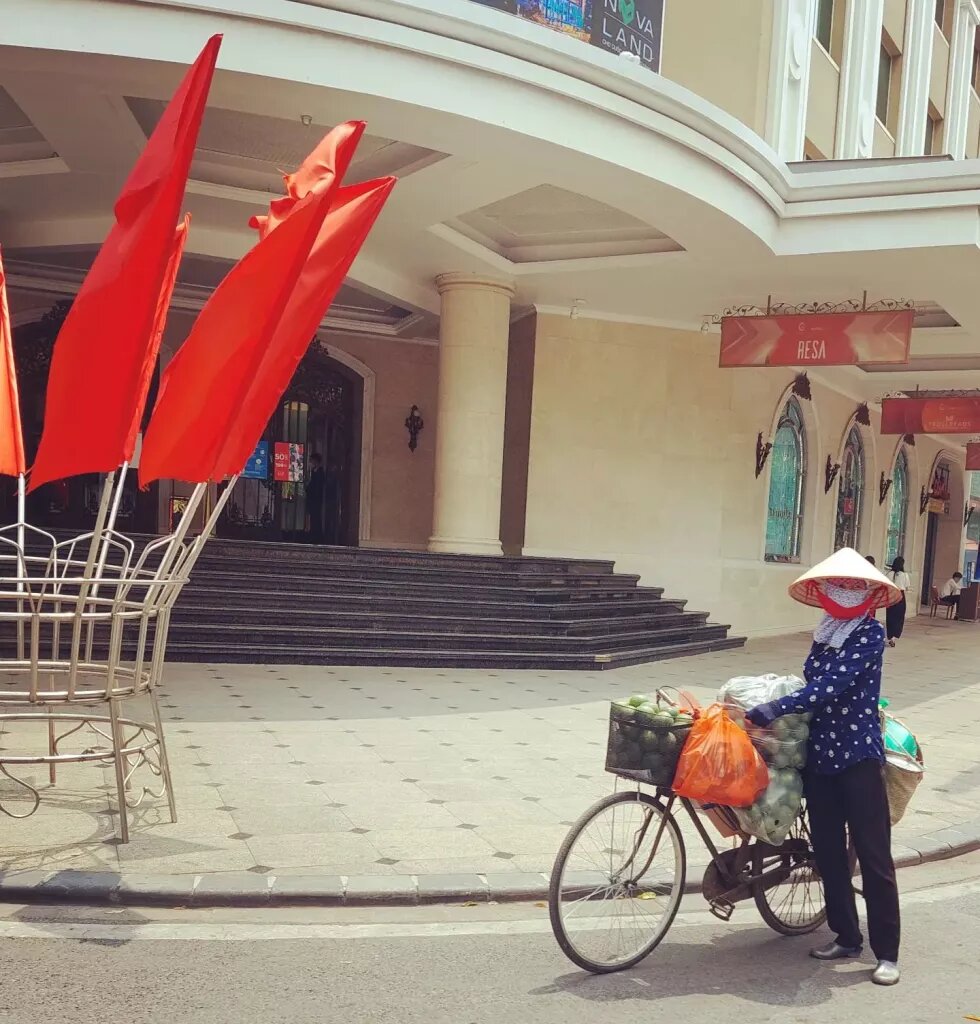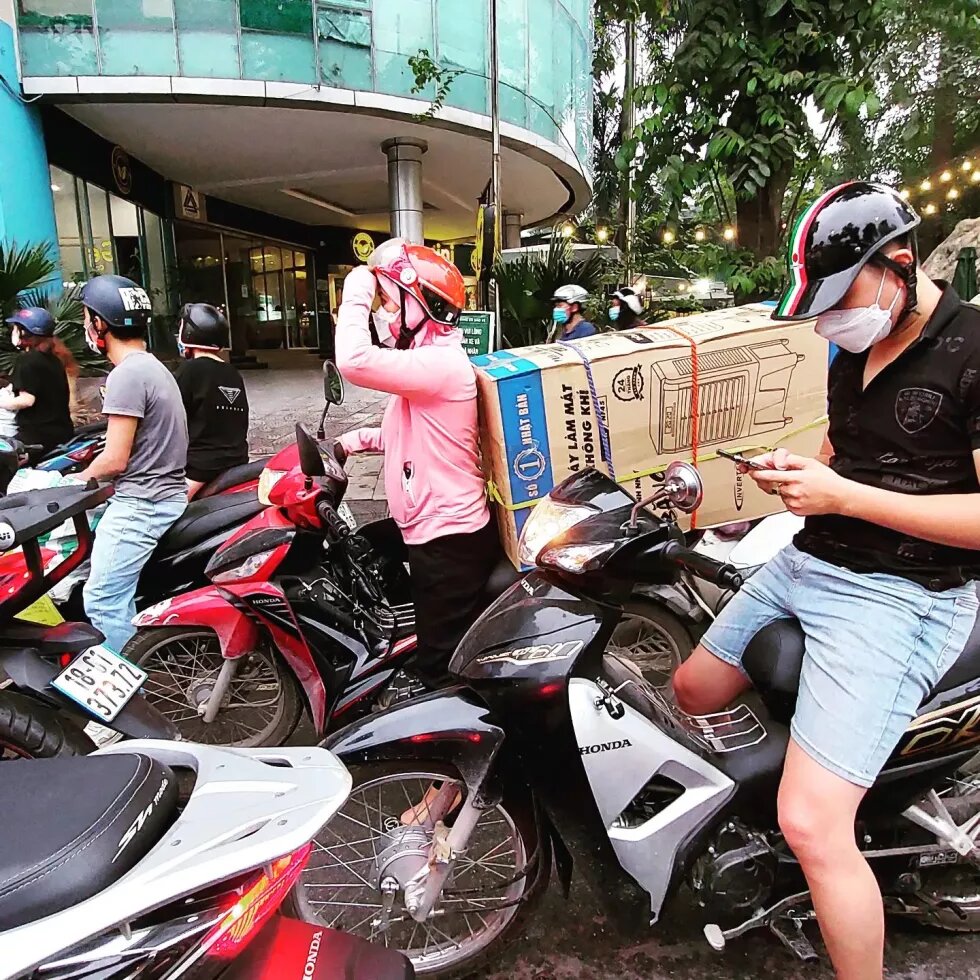
Nguyen Qui Duc, radio broadcaster, writer, designer, editor and translator, based in Hanoi reflects about the impact of the pandemic on Vietnamese society.
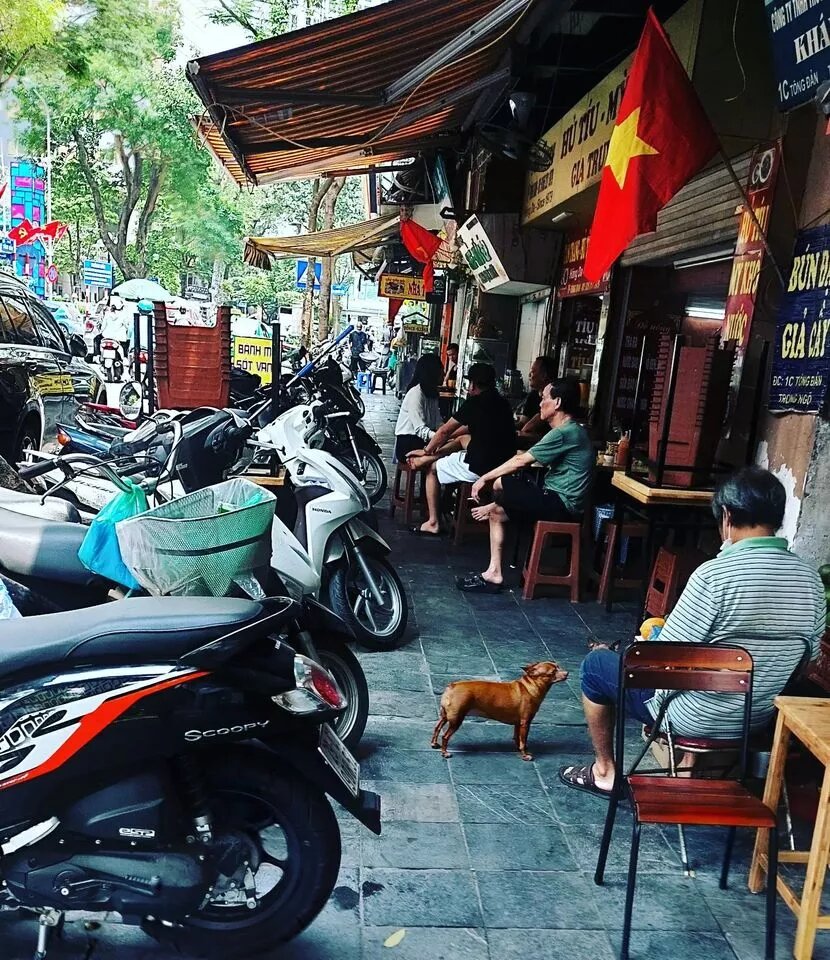
THE MASKS, THE MASKS
So, the masks stay on. Take a walk on the streets of Ha Noi, or Saigon, you’ll notice an overwhelming majority of the people are still wearing COVID protective masks. That is, they wear it riding around on motorcycles all over town. Meanwhile, cast a glance towards the multitude of sidewalk cafes and food stalls and you will see the masks are all off.
Wearing the masks on the street may be a protective measure against COVID-19, but it could also be protection against traffic cops – notoriously known for their petty corruption -- who are meant to enforce public rules, including the mandatory wearing of masks. People will tell you it’s a potential two million Vietnam Dong fine (roughly 85 USD). But nobody’s sure whether the rules still apply. Nobody I know has been fined.
I suspect keeping a mask over your mouth and nose has become a habit after over two years of living with the pandemic. And another reason comes to mind: community pressure. In a country that, although strictly ruled for nearly 70 years under communism, Confucian standards still apply, and behaving like others around you is obligatory. If your elders, friends, neighbors and colleagues do it, you do it yourself. There’s little incentive to stand out from the community, to be independent and show disrespect.
But in the past several months, since the government relaxed the rules on COVID and allowed the re-opening of businesses, schools, as well as mass public activities, attitudes have truly changed. People no longer post COVID test results on social media. The assumption seems to be everyone’s being vaccinated. The official media stopped publishing number of infected cases some three months ago. Like in the rest of the world, get vaccinated and live with COVID is the general consensus. You can go to public events, from massive rock concerts with five thousand people, to sitting in crowded beer halls and tiny cafes with plenty of people. And once you get off your motorcycles and scooters, the predominant mode of transport in Viet Nam, you remove your masks within quick seconds. And internal travels have picked up, while many people here are itching to travel overseas. The backlog for a visa appointment with the U.S. embassy, for example, means that you can apply now but won’t be processed until early next year. It is believed this is due to an upsurge in visa applications.
A REVIVAL
It's been over two years since the first recorded case of Coronavirus infection in Viet Nam, in January of 2020. Now the terrible memories seem to be fading. It’s not been easy for many of the people in the country, even if, by comparison to many places in the world, the numbers of infected and deaths in Viet Nam remain low. As of May 27, 2022, Viet Nam’s Ministry of Health confirmed a total of 10,714,008 cases of COVID-19. It has also claimed that nearly 10,000 affected patients have recovered and been discharged from hospitals. Viet Nam has also recorded over 43,000 deaths due to the pandemic. (In private, journalists and observers have suggested that official data reflect only about a third of the actual deaths).
THAT FIRST TIME – AN ACCEPTABLE POLICE STATE
During the first lockdown, in the first trimester of 2020, the horror of deceased patients wasn’t apparent at first. There was scarcely any such news. It was the fear of the first cases, and the beginning of limited lockdowns from district to district. Then came the total lockdown which filled us with depression and anxiety. None of us really knew what was going to happen while we worried about family, businesses, money, and of course, getting infected, but generally we accepted the severe measures imposed by the government.
March of 2020, some 45,000 people were quarantined, mostly in military-run centers. You began to understand the people’s acceptance of government strict measures and were relieved that something was being done to contain the infection rates.
Some of us set aside the fears and thought we could stay home to do all the things we’d always wanted to do. In truth, the depression and fear prevented any activities – perhaps with the exception of cooking and posting images of food on social media. As time went by, we did what people worldwide did under the lockdown: we watched one movie after another, shared with friends far and near the frustration of being stuck indoors, many of us here with an extended family including children.
What was most amazing was how people then marveled at how the country dealt with the virus situation. Some expressed doubts about government reports and statistics but there was a clear sense of community on the streets, in public spaces, and on social media -- fueled both by fear, and anger at those “irresponsible enough to help spread the disease.” No one complained about the intrusion from neighbourhood health and security committees, or the police with endless forms for you to fill out: reports of activities, travels, health issues, and more personal information.
If a communal sense fell dormant in Viet Nam in the last years with the adoption of selfish capitalist attitudes, it was coming alive now. The government and the party have long had organizational entities and resources - police, army, patriotic fronts, etc, that were now available to deal with issues affecting the masses. They could now call on retired doctors and nurses, or state controlled agencies and enterprises to join in the fight. Hundreds of state employees volunteered to work without pay. Private individuals came together to help build devices that would discharge rice, to those in difficult circumstances, much like an ATM that would discharge cash. At such places, in supermarket, people patiently queued up and stayed in line orderly, meters apart, without a comment or complaint.
There was pride too, that officials were relentless and seemed to be handling the situation better than Western countries. Businesses were failing, like anywhere else, however, a stoic, accepting attitude prevailed. People were aware and joining hands, many expressing support for a government that they once often criticized, even sending money to state entities handling the virus crisis. It was as if there's a forgiving moment about a police state and communism.
Remembering those moments is to remember how chaotic Vietnamese society can be, and then, all of a sudden, faced with a particular threat, the Vietnamese rose up to challenges in unity. It had happened for hundreds of years, especially in case of war, and with the COVID threat, politicians and the media began swiftly to make references to fighting a war, complete with analogies to strategic and triumphant offensives.
Throughout the first period of COVID, there were several outbreaks in many provinces, but the local and central governments once again imposed various degrees of isolation within the population and managed to contain the spread of the virus. In hindsight, instead of relief and pride, these outbreaks should have been met with renewed strategies and closer examination of what was happening elsewhere. It all could have been summed up in two words: Delta, and vaccination.
THE DISASTROUS SECOND TIME
When the Delta variant arrived, it was disastrous. People talked of officials “drunk on their recent success,”, “resting on their laurels,” or “being asleep at the wheel.” Harsh words, but the widespread images of overfilled hospitals, rumours of shortage of body bags, and soldiers delivering boxes containing people’s ashes did much to fuel people’s anger and fears. May of 2021 saw COVID cases skyrocketing to over 350,000. It didn’t help that just before, the government allowed for the celebrations of the anniversary of the end of the Viet Nam war, on April 30th, and the customary the International Workers holiday on the 1st of May. Unsuspecting people took holidays and gathered in many places, spreading the virus.
In fact, people were blaming the poor response to the outbreak on the leaders’ earlier preoccupation with the Communist party’s 13th national congress, in January of 2021, and the subsequent elections. Local isolation on infected area became nullified when the government exhorted the population to go out and vote. This also was very close to the national Lunar New Year Holiday – and control or monitoring of the movement of the people became even more difficult.
To confuse the situation, many party cadres and officials at various levels of government were being removed for failing to control the epidemic. This simply fueled the people’s suspicion that the factions inside the party and government were more concerned with placing allies into positions of power than with dealing with the pandemic. Since then, the situation has continued, the suspicion remains, and foreign diplomats and observers began complaining that, with the personnel changes, there was no room for creativity in the face of the spreading pandemic. Newly installed officials made no decisions that could jeopardize their positions.
To be fair, as the epidemic spread to various locales in the country, it was impossible to monitor and trace who infected who and where. The government built 30 field hospitals in response, with over 30,000 beds. Meanwhile new lock-down measures meant some 35 million people were under quarantine both in the capital and in the provinces. Small and middle businesses began complaining even louder. People could no longer be counted on to help out, a sense of community was evading society.
EVAPORATION AND EVACUATION
Partial or full lockdowns continued through the middle months of 2021, the goodwill amongst the people evaporated. Part of that was the miscalculation of the government in the south, who first allowed people to return home. This involved thousands of migrant workers from a multitude of factories. The images of such masses of poor laborers trying to leave major metropolitan areas on motorcycles, buses, bicycles, and even on foot to return to their village were heartbreaking.
Following business complaints, and fears of the disease spreading further with such movements, the government quickly reversed earlier decisions. Workers were now to stay put: that meant crowded conditions inside the factories, makeshift beds, or sick people living in dorms with no money or food. The government lost any credibility.
It took these incidents, and the worsening of the virus situation, for Prime Minister Pham Minh Chinh to declare that Viet Nam will have to face a protracted battle against the pandemic. The extended closures of businesses and quarantines against the population no longer worked.
LIVING WITH THE BEAST
Viet Nam would have to live with COVID virus. This was a momentous change in attitude within the country and what may have saved the situation until today.
What seem to be a miracle was the swift engagement of the leaders in procuring vaccines. Some governments in the West announced quick donations of vaccines – but somehow, the government negotiators got around to bringing in all sorts of vaccines from around the world. The central government talked of producing its own versions of the vaccines, with potential help from places like India and China.
Day after day, state loudspeakers went into overdrive to urge people to sign up for vaccinations. The local health clinics sent notices out, and schools and hospitals began being used to host mass vaccination sessions. Morning, day, and night.
Enough people refused the Chinese vaccines due to age old suspicions, as well as a fear that it was the Chinese who spread the virus and was in no position, technically and medically, to offer good vaccines.
Still, somehow, people showed up at such places, lined up and patiently went through the procedure. Then they waited for the second shot. And the government fulfilled the intention to carry out a thorough vaccination campaign.
It all happened within two to three months, first in the capital and other big cities, then in the rest of the country.
TRAFFIC AND THE RAT RACE
Drive around Ha Noi or Saigon now and you will immediately feel the pollution, you will get frustrated with the interminable and chaotic traffic. You will notice the honking cars, the din of commerce, the tourists and young people out taking selfies. It’s as though no pandemic had visited here. People are reveling in recent triumphs of the Vietnamese sports teams during the Southeast Asian Games – pouring out by the thousands in the streets in celebration. And there are some good news: Viet Nam’s National Administration of Tourism reported that nearly 200,000 foreign visitors came through from January to April of this year. That’s a 284 per cent increase compared to the same period last year. Yet, the hospitality and tourism industries have a long way to go.
Around town, there are still plenty of “For Rent” signs. That would be the former hotels, restaurants and businesses catering to tourists. But small businesses are open, Grab bikers crisscross the town, delivering food and goods. And during rush hours, the hordes of people are once again at it – on thousands of motorbikes, fighting to squeeze past the cars. People are going to work, running businesses, filling up beer halls and small restaurants.
And in these places, they share the news. Of another General, or a government department head being demoted or stripped of membership in the communist party. This month, the mayor of Ha Noi and a host of other officials, including the Minister of Health, are being demoted and removed for being involved in a nation-wide scam to inflate COVID test kit prices. Other similar cases are exposed in the state media, and on social media. There are questions as to how real and meaningful the party chief’s vaunted anti-corruption campaign really is, or is it factional disputes among the top leadership.
The conversations will then turn to crypto or whatever the currencies being bought, sold and traded. Then it will be land prices somewhere. Or it’s about the price of gas, and the fear of inflation.
In short, life has somewhat returned to some degree of normalcy. And it appears the fears of COVID has subsided tremendously. Or perhaps it’s been replaced by concerns about a stronger revival of businesses and opportunities. The rat race is upon the people yet again, despite earlier moments of quietude during the lock downs and thoughts of slowing down.
From the street conversations or social media commentaries, there still seems to be a lack of trust in the party and the government. With the pandemic’s “mismanagement” and the constant changes in personnel, no confidence is being generated.
Meanwhile, to look back upon these last two years of the pandemic is to once again be reminded of certain central Vietnamese characters as expressed by the people. A sharp unrelenting will to live, a pragmatic approach to survival against the misfortunes in life, and an insistence on hope.
Wait for the people to remove the masks that they wear in traffic and look again: the worried faces and grim expressions remain, but they can barely hide the legendary Vietnamese resilience.
__
Nguyen Qui Duc worked for 25 years in public media in the US and the UK, focusing on Asian issues. He's been living in Ha Noi for the past 15 years.
The views expressed in this article are not necessarily those of Heinrich Böll Stiftung
